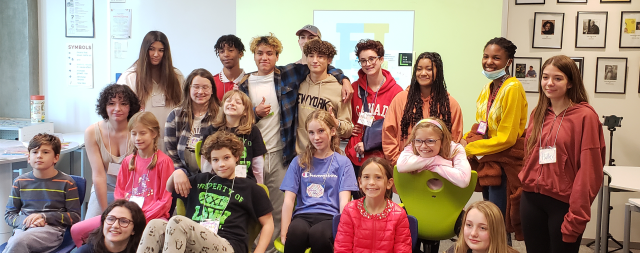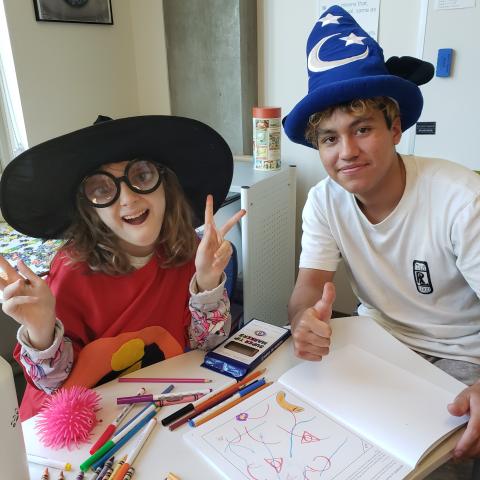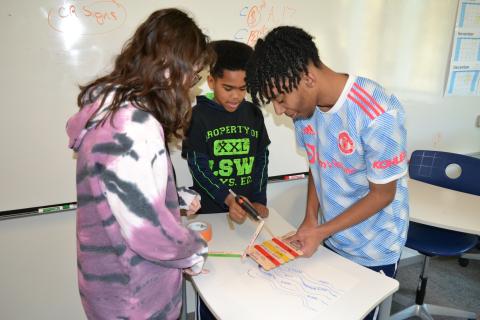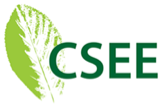

Marla Brazier
English Teacher Eye to Eye Advisor
A New Look for Eye to Eye
In the wake of a pandemic-based hiatus, The Lab School chapter of the Eye to Eye program saw an opportunity to build a bridge connecting students across divisions. The program expanded to include students in the Lower and Middle School who would be mentored by their counterparts in the Upper School.
In 2015, The Lab School was chosen to be the first high school chapter of Eye to Eye in the Washington, DC area. Eye to Eye is a nation-wide mentoring program that bridges the age gap between students of all ages who have learning differences like dyslexia and ADHD. College mentors are matched with mentees in middle school, while high school chapters like that of The Lab School would be paired with nearby elementary schools.

For The Lab School, this mentee school was DC’s Stoddert Elementary and for six years, Lab students enjoyed a fruitful partnership engaging with their younger peers. Unfortunately, Eye to Eye was one of the many educational programs impacted by the shutdowns resulting from the Covid-19 pandemic. Even once both schools had reopened in person, new security measures made continuing the partnership unsustainable.
Despite these disappointing circumstances, Upper School English Teacher and Eye to Eye Advisor Marla Brazier was determined to keep the program running and saw an opening in last year’s divisional reorganization at The Lab School. As an alternative to working with another school, the Upper School students in The Lab School Eye to Eye chapter would mentor younger Lab students and build a bridge between the school divisions within Lab itself.

“There was an opportunity to establish community in ways we hadn’t been able to before,” says Ms. Brazier of the initial decision to expand the Eye to Eye program to the Middle and Lower Schools. Though certain schoolwide events like the Identity, Arts, Music, and Unity (IAMU) festival or the Spirit Week pep rally bring together students from Lab’s Foxhall and Reservoir campuses, the Eye to Eye program provides an opportunity for some of these students to truly build a connection with each other. For each of the 18 Eye to Eye meetings, students from the Middle School (all from the 5th grade, though going forward the program will also be open to students in the 6th grade) and the Lower School travel to the Upper School for their “Art Room” meetings with the mentors in the program. Each meeting revolves around the students working on a different art project that serves as a springboard for conversations about having confidence in one’s learning abilities. Though the activities are all different, at their core, they each provide an opportunity for students to discuss the challenges of living with a learning difference with mentors that know exactly what they are going through.

One week, the students spent their time together literally building bridges. In small groups, students used construction materials decorated with words describing their strengths to build small model bridges that traversed a river filled with their challenges. Whether words “math,” “spelling,” and “reading” described students’ strengths or their weaknesses, the exercise showed the young mentees that their older counterparts face some of the same struggles that they do, but they can overcome them by focusing instead on their strengths and abilities.

For the mentees, the meetings can be a window into the future. “It’s more than just ‘I have a learning difference and you have a learning difference,” says Associate Head of Lower School Judy Shincarick, who coordinates the Lower School side of the Eye to Eye program and provides a calming presence to the students from Foxhall. For the mentees “it’s about learning to project out their futures and see themselves in the Upper School. The mentors are a model for what it looks like to be older and have the tools to overcome the challenges that they’ve faced.” Figuring out how to communicate this lived experience to the mentees is an important lesson for the Upper School students. “It’s a win-win for the Lower School and the Upper School. The older students learn to talk about themselves in ways they don’t normally have to,” says Ms. Brazier.

In some instances, the bonds between the students have even appeared outside of the Eye to Eye meetings. Ms. Brazier recalls attending the LabDrama production of The Odyssey in the spring and hearing a mentee’s voice following the performance. “She had demanded to come to the play and give flowers to her mentor. She couldn’t be kept away.” By forging connections like this, the Eye to Eye program has helped strengthen the ties between the Divisions at The Lab School. In just a few years, some of the mentees will themselves be old enough to be role models for young students building confidence in their own learning abilities.
Strong ties between The Lab School and Eye to Eye
The Lab School had connections to Eye to Eye even before it was chosen to host the program’s first high school chapter. Founders David Flink and Jonathan Mooney had visited the school on numerous occasions, including to speak about their book Thinking Differently, a comprehensive guide to help parents understand their children’s learning differences. In 2009, Jonathan Mooney was recognized as an Outstanding Achiever with Learning Differences at the Lab School’s Annual Gala. Several of the student coordinators from The Lab School Eye to Eye chapter have also continued their work with the program after leaving. Grayson Butler ’17 was part of Lab’s inaugural Eye to Eye mentor group and went on to work for the national Eye to Eye program, while Davis FitzGerald ’18 founded a chapter at Vassar College. You can learn more about Eye to Eye by visiting the website www.eyetoeyenational.org.


